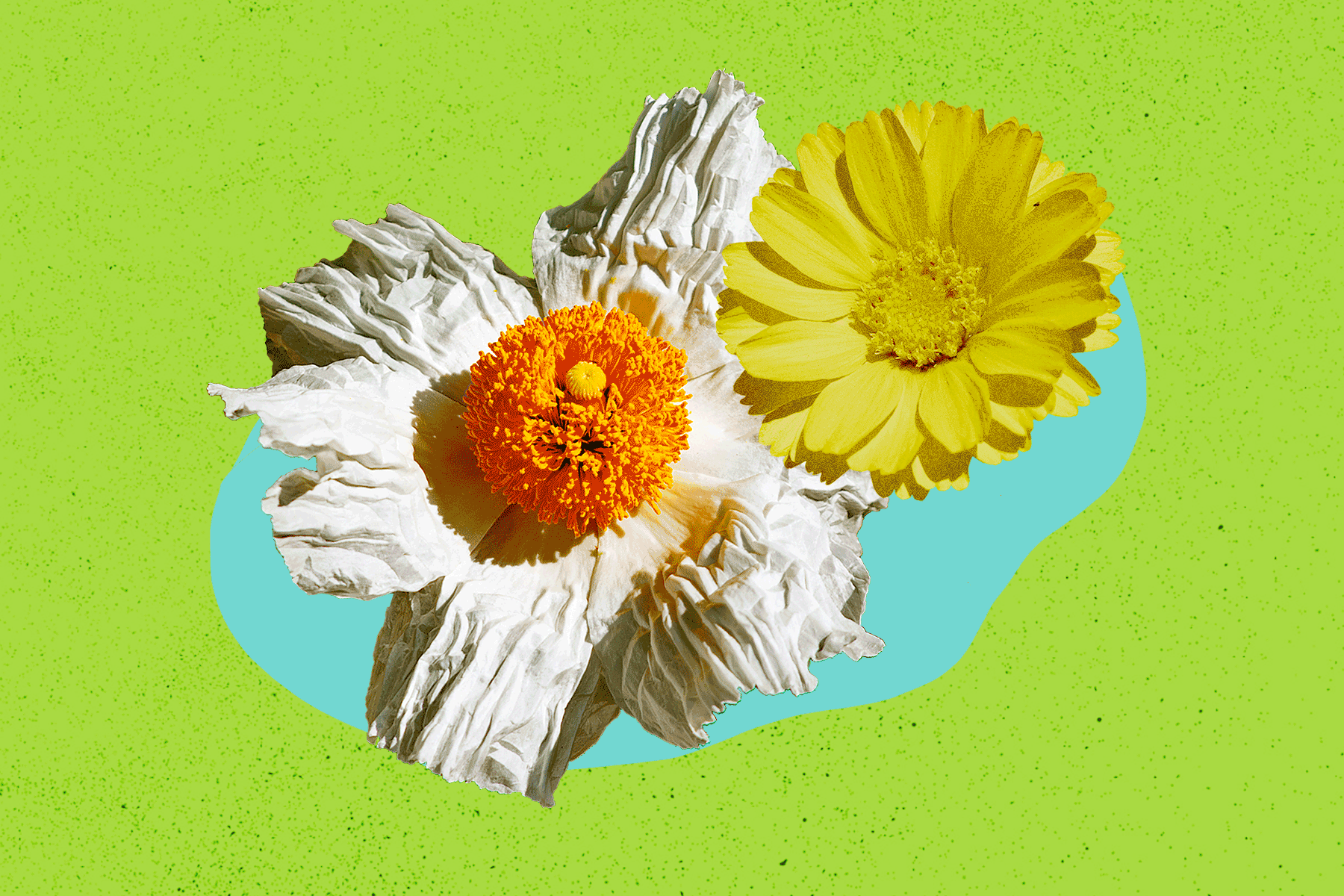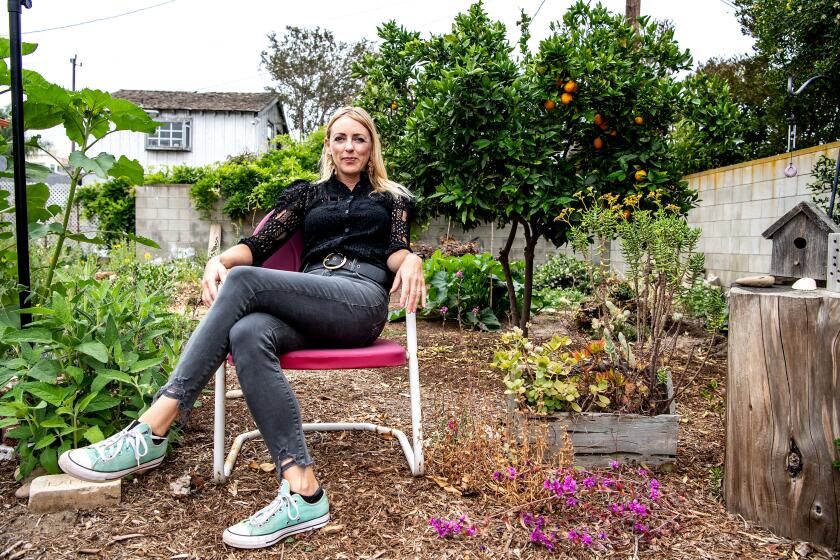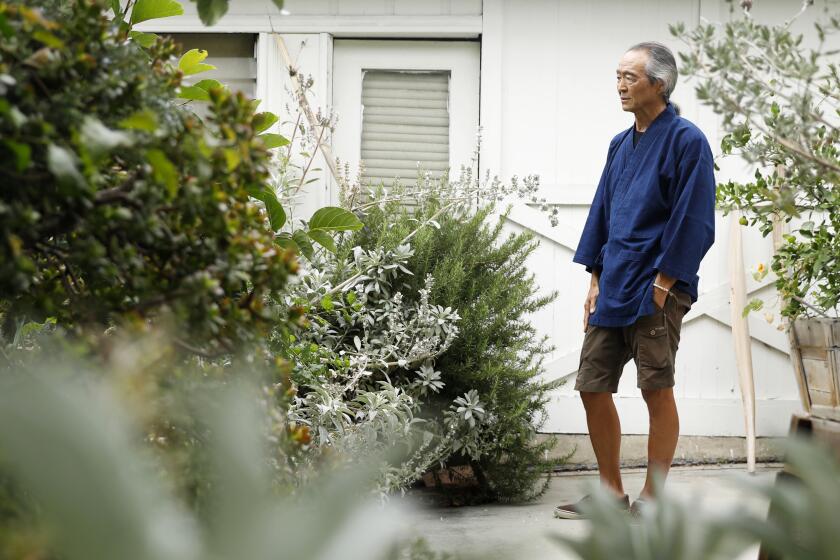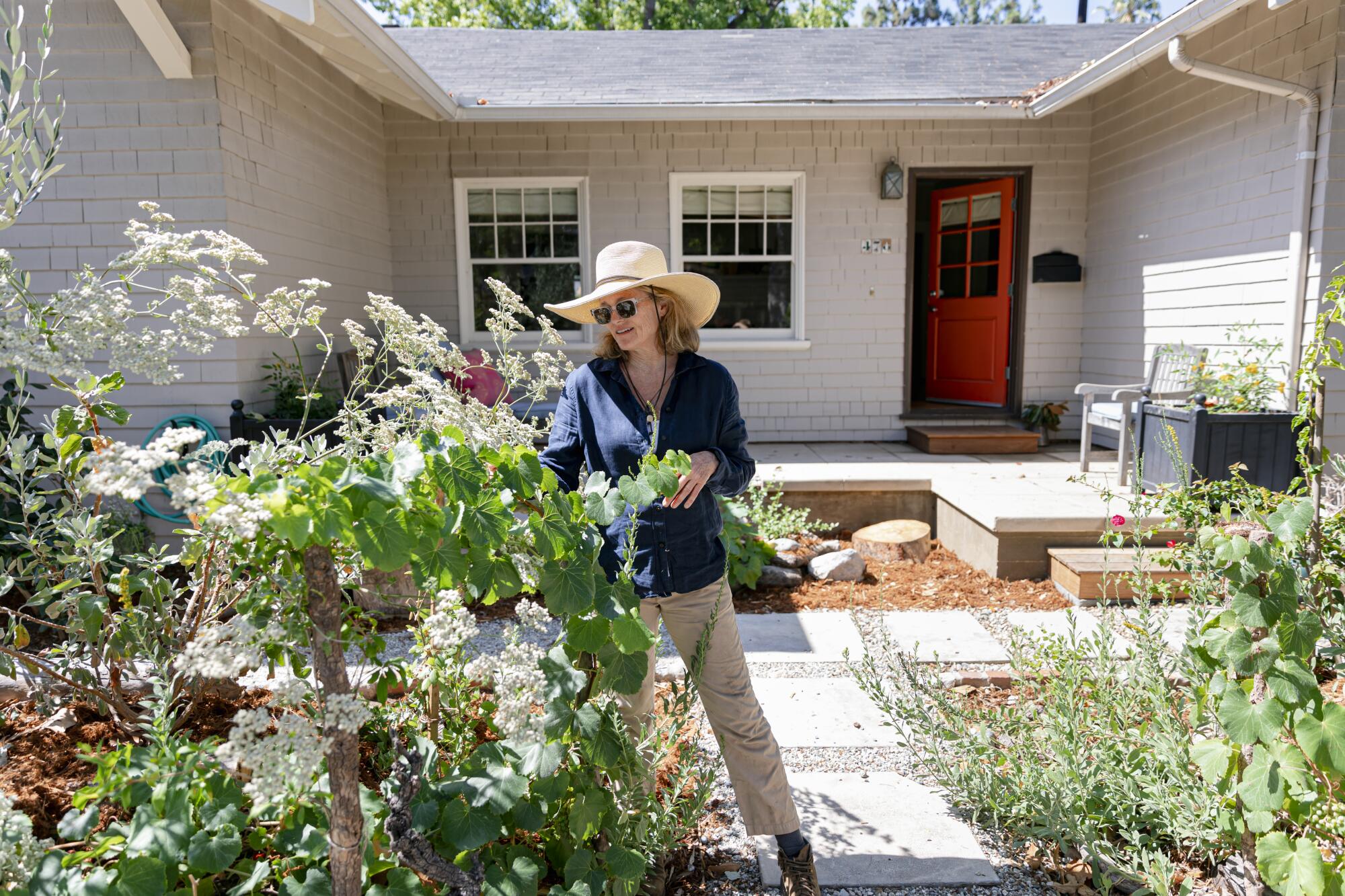
- Share via
Lawns are symbols of Los Angeles’ past. In this series, we spotlight yards with alternative, low-water landscaping built for the future.
When Elana O’Brien decided to eliminate the front lawn outside her Pasadena home, she had three goals: water conservation, increased privacy and a view more natural than a city street and the seasonal decorations in her neighbor’s yard.
Smothering her 850-square-foot lawn with cardboard and mulch — a.k.a. sheet mulching — wasn’t enough, O’Brien said. She wanted to add some height and contour to her yard, and she found the answer with — literally — a lot of sticks and stones, using a process known as hugelkultur.


“I wanted a water savings garden that wasn’t about succulents,” said O’Brien, a professional organizer who decided to tackle the project by herself after taking a workshop sponsored by the Pasadena Department of Water and Power. The class was taught by Leigh Adams and Shawn Maestretti of Studio Petrichor, a landscaping company focused on rainwater harvesting, soil regeneration and drought-tolerant gardens.
Like many other adherents, O’Brien was captivated by Maestretti and Adams’ lessons in removing a lawn and rebuilding depleted soil using sheet mulching, a.k.a. lasagna mulching, and inspired by their use of hugelkultur to create plantable berms made from cut-down trees and branches covered in soil, compost and mulch.
“The idea just appealed to me because I could use what’s around me: beautiful pieces of branches and leaves,” O’Brien said. “And I have access to a lot of cardboard from helping my clients move, so really I had pretty much everything I needed to make my garden soil thrive.”
As the drought continues, Californians are tearing out their lawns. Here’s a DIY guide to killing grass to prep for a drought-tolerant landscape.
O’Brien took her first workshop in September 2019 and became a convert, attending more classes that fall and participating in learn-while-you-work sessions around the valley, spreading sheet mulch and building hugels. She created a plan for redoing her front yard during one of the workshops and then submitted it to city officials so she could get a $1,600 rebate for removing her lawn.
The project meant she had to create swales in her yard where runoff from her roof and backyard would drain into the soil instead of the street. She already had rain gutters, so the trick was getting the runoff to drain into the soil and not down the driveway. And she had to make a plan for what she intended to plant.
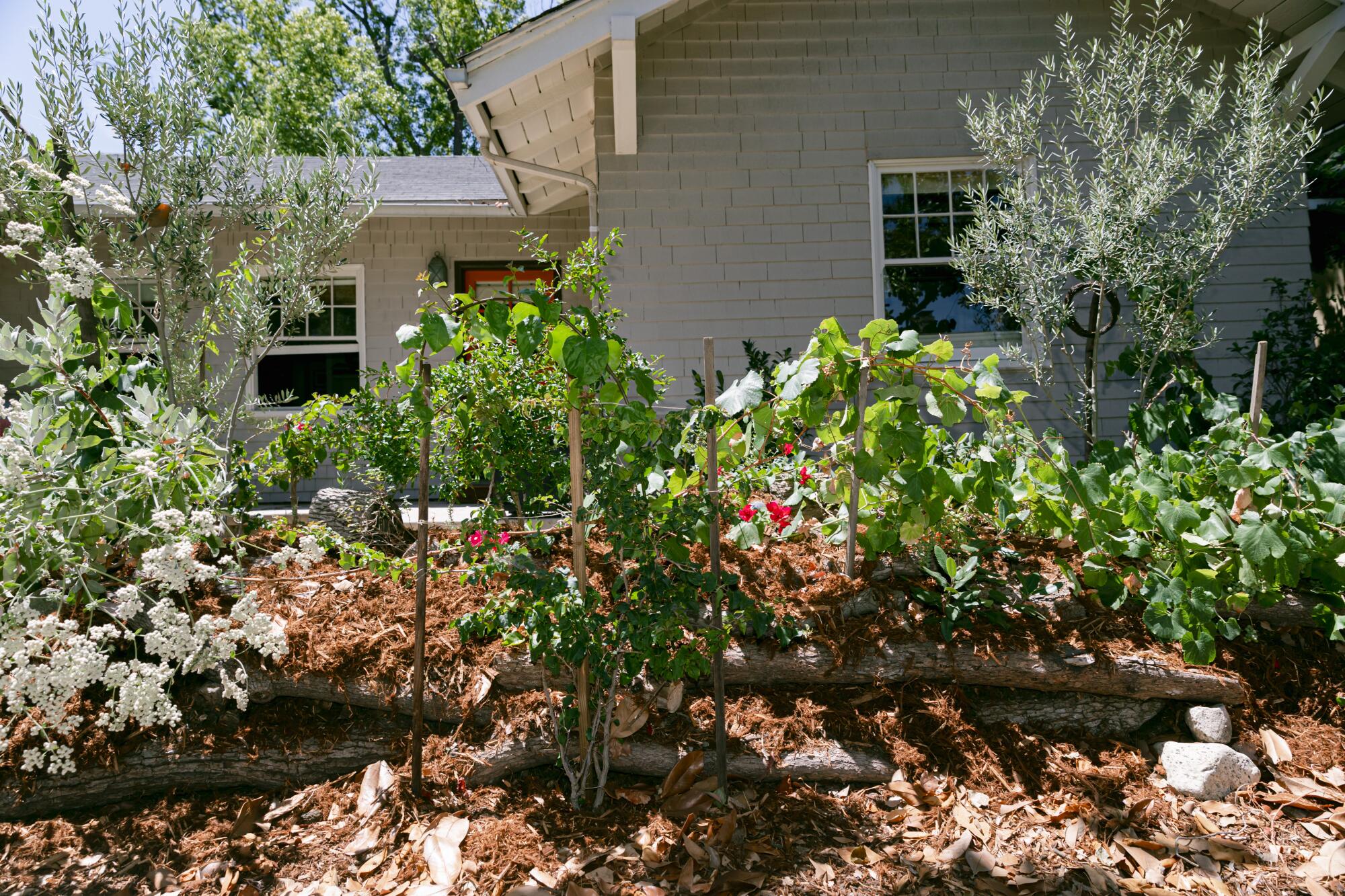
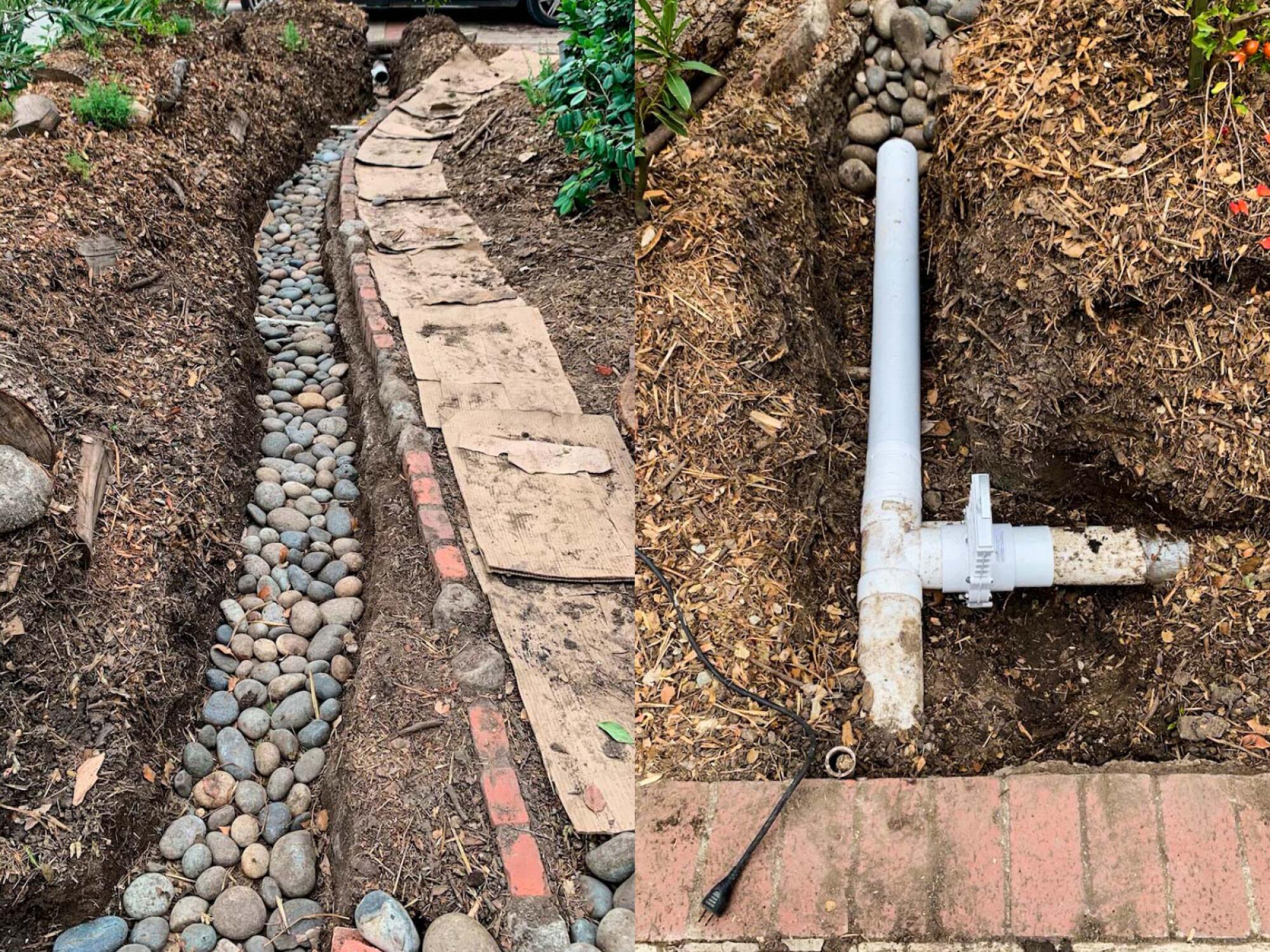
Her yard was basically grass, azaleas and camellias, pretty standard fare for her pastoral (and very tony) Madison Heights neighborhood in Pasadena, which is full of stately old homes — her relatively small abode was built in 1911 for the son of the owners of a nearby estate. She bought the house in 2007 but didn’t begin the yard work until March 2020.
She hired someone to dig out a shallow ditch along the edge of her walkway, about 13 inches deep and 12 inches wide, and filled it with a few inches of rocks and then wood chip mulch, saving the dug-out soil to help cover her hugel berms. This was her swale, a kind of catchbasin for rain runoff from her roof and backyard. A PVC pipe connected to the gutters and existing system from her backyard now diverts all that rainwater (when it ever comes) to the swale instead of the street.
Later that month, O’Brien took advantage of a rainstorm to start laying down the cardboard to smother her lawn — which caused a little consternation among her neighbors.
Lasagna/sheet mulching is a fairly simple process: Cover the lawn with cardboard that overlaps at least 6 inches all around to discourage grass from growing through the cracks, get the cardboard really wet to kickstart the decomposition process, and then cover it with at least 4 inches of mulch, such as wood chips.

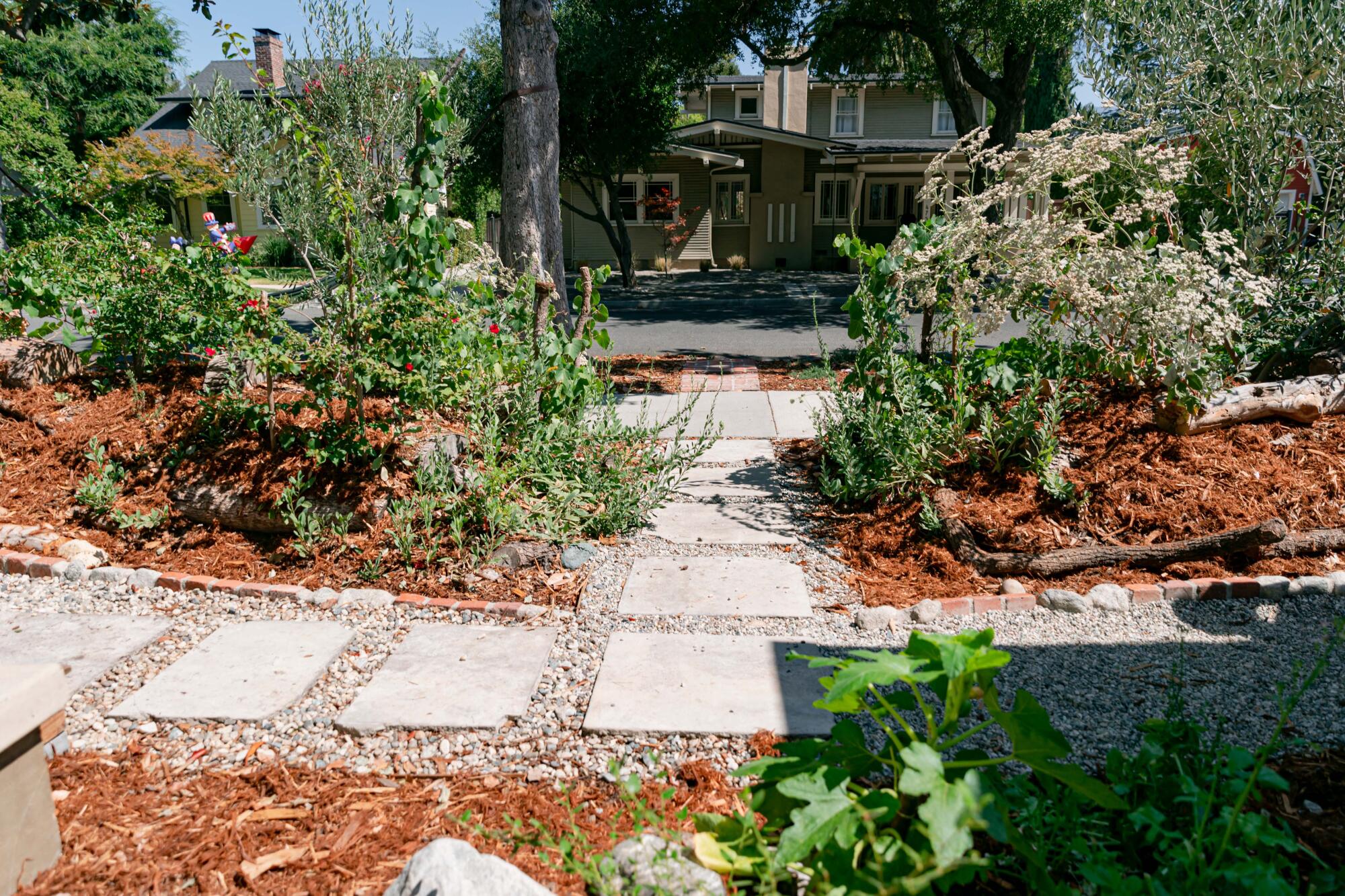
“I figured the rain would make things easier,” she said. “Water is how you get the cardboard to fit and conform to the land, so if I’ve got precious water running down my gutter, I’m going to put my cardboard in the gutter to soak it up.”
Her neighbors, however, saw the cardboard as litter. “I only left it there for a short time to get wet,” she said. “But my neighbor came out and started putting my cardboard in his recycling bin and I had to go out and get it back.”
There was more confusion when O’Brien had a load of recently trimmed logs delivered to her front yard. Someone called the city to report the logs as a possible fire hazard, she said — ironic, since she learned about building water-saving hugels through a city-sponsored program.
She did get a call from the city, and the matter was dropped after she explained her project. “But I knew I had to work quickly,” she said, in part to help her neighbors see her vision and in part because she planned to landscape with drought-tolerant and native plants, and the best time for planting — in the cool winter months — was rapidly passing.
Even California native plants can dry out in the summer. But these varieties will still look good in Los Angeles yards and gardens during the hottest months.
The idea behind hugelkultur is that the logs help collect and retain moisture and encourage the growth of beneficial microorganisms in the soil — not to mention repurposing wood that would otherwise be thrown away.
O’Brien got all her logs for free. “I could see the city had marked two magnolia trees nearby that were diseased, and a neighbor was having a camphor tree cut down because it was diseased, so I asked the [tree-cutting] guys if I could have the wood.”
Most tree trimmers are happy to provide logs and even wood chips for free to save them the expense of having to pay for disposal, and O’Brien said they were willing to cut the logs into short lengths that she could easily handle. Sometimes she picked the logs up in her car; other times they were delivered.
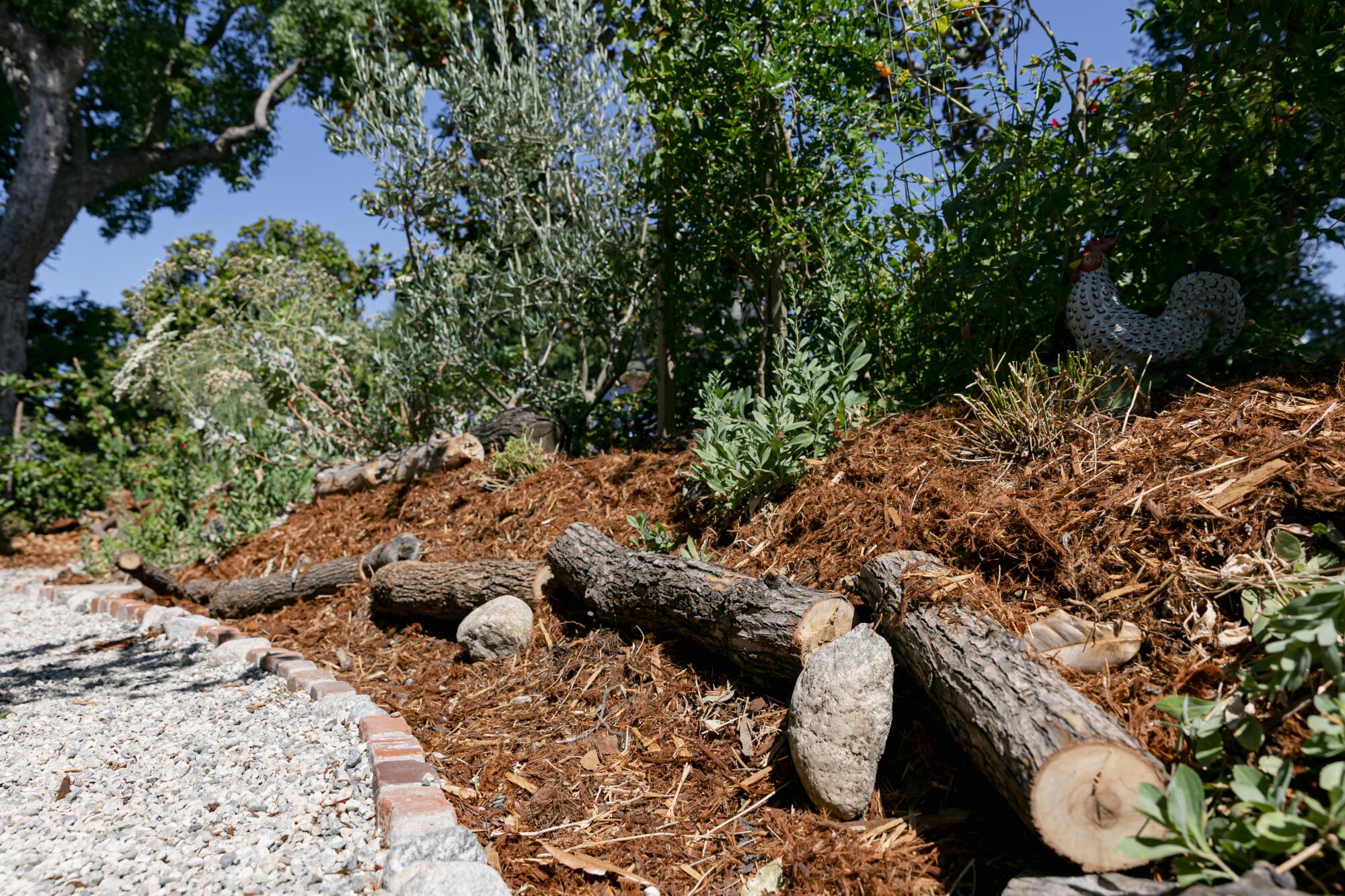
She even took to collecting interesting branches she found on the street — including a large sycamore branch she managed to thread through the seats of her Volvo station wagon.

Subscribers get exclusive access to this story
We’re offering L.A. Times subscribers special access to our best journalism. Thank you for your support.
Explore more Subscriber Exclusive content.
The limb just fit, she said, or so she thought, until she closed the rear hatch and the branch cracked her windshield. “It was just too long,” she said ruefully, but the story has a happy ending: Insurance fixed her cracked windshield and she was able to place the sculptural branch along the side of her yard.
Creating the hugels was fun, O’Brien said. “It’s like an art project for me. The hugels create a three-dimensional space to plant on, as opposed to just a flat surface, and they give you an outward view and inward view, which I love.”
Sarah Lariviere tore out her lawn and paid for a low-water replacement with a turf removal rebate. Here’s how she made it happen.
O’Brien stacked and staggered logs between the public sidewalk and a small path outside her home, creating a berm about 3 feet tall, with dips and wells to hold soil and a thick layer of gorilla mulch. She used dirt from her own yard, including the parkway between the street and sidewalk. The grassy parkway was higher than the sidewalk in many spots, so she hired someone to remove some of the soil so water wouldn’t run off onto the sidewalk. She also dug a more shallow and narrow swale in the parkway along the sidewalk and filled it with mulch to collect rainwater runoff.
By May, she was ready to plant. She had four olive trees in pots about 6 feet tall that she wanted to plant strategically in the front yard to provide a privacy screen. And she was excited about adding vining plants like the native Roger’s Red grape (Vitis ‘Roger’s Red’) and bougainvillea with its bright fuchsia flowers. She browsed the California Native Plant Society’s database, known as Calscape, and the Crescent Farm at the Los Angeles County Arboretum for inspiration about what else to plant and how to design her new garden.
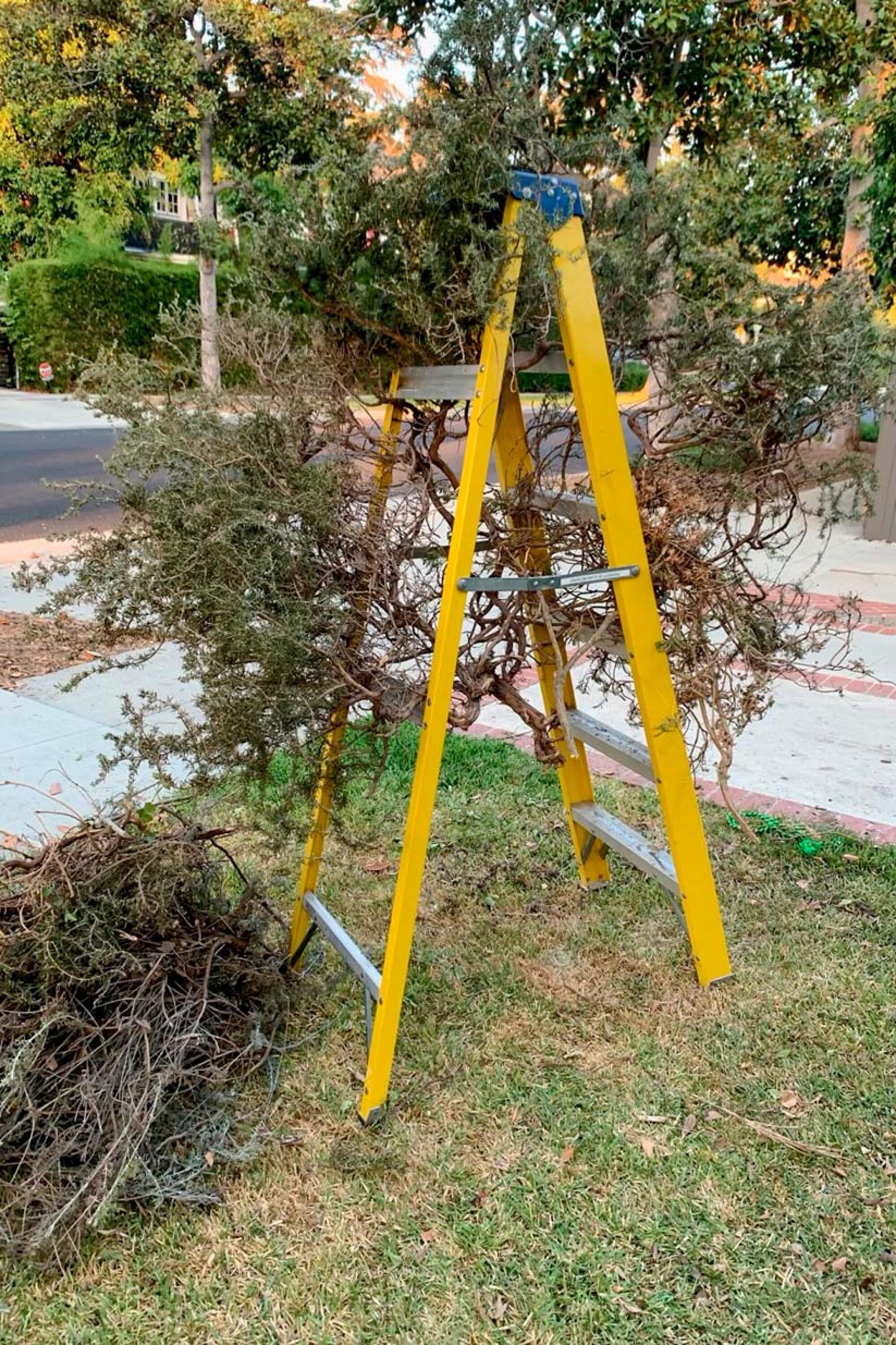
Finding the right locations to plant took a little ingenuity. Before she built the hugels, she got a bright yellow stepladder, decked it with shrub branches and then moved it around the yard to decide the best spots for planting trees and other taller shrubs to create a privacy screen.
Her other plantings included native plants such as St. Catherine’s lace, California buckwheat, toyon and coffeeberry, as well as a pomegranate tree — a recommendation from Adams because its shaggy growth provides lots of privacy in addition to yummy red fruit. She’s planted lots of yarrow in the parkway hoping it will spread and flower, as well as yellow-blooming goldenrod and purple verbena.
This is only the third season for her garden, but the plants are finally taking hold, especially the grape, bougainvillea and olive trees, which are growing with abandon. She’s training the vines to grow on strings over her pathway in the hopes of creating a green shady tunnel. And she’s basking in the many positive comments from passersby.
Georg Kochi moved to his family home and tore out the lawn. As he learned about native plants, he fell in love with drought-tolerant landscaping.
“People were a little suspicious in the beginning because it was all brown,” she said, “but now people stop and say, ‘I really love what’s happening in your yard. It’s really coming along.’ And I got most of these things for free. I’m saving water and it’s a benefit for my budget too.”
For the record:
3:41 p.m. Oct. 20, 2022The amount of water used Elana O’Brien’s garden for the first six months of 2022 was 11 HCF, not 1,100.
After her rebate, O’Brien says, she spent just $2,124 on the initial project. There have been some additional expenses since then — buying more gorilla mulch at Whittier Fertilizer Company in Pico Rivera and purchasing plants at nurseries ranging from Home Depot to the Theodore Payne Foundation — but the savings on her water bill have been dramatic, she said. Her usage for the first six months of 2022 was 11 HCF (1 HCF, or hundred cubic feet, is 748 gallons), less than half the 26 HCF she used during the first six months of 2020.
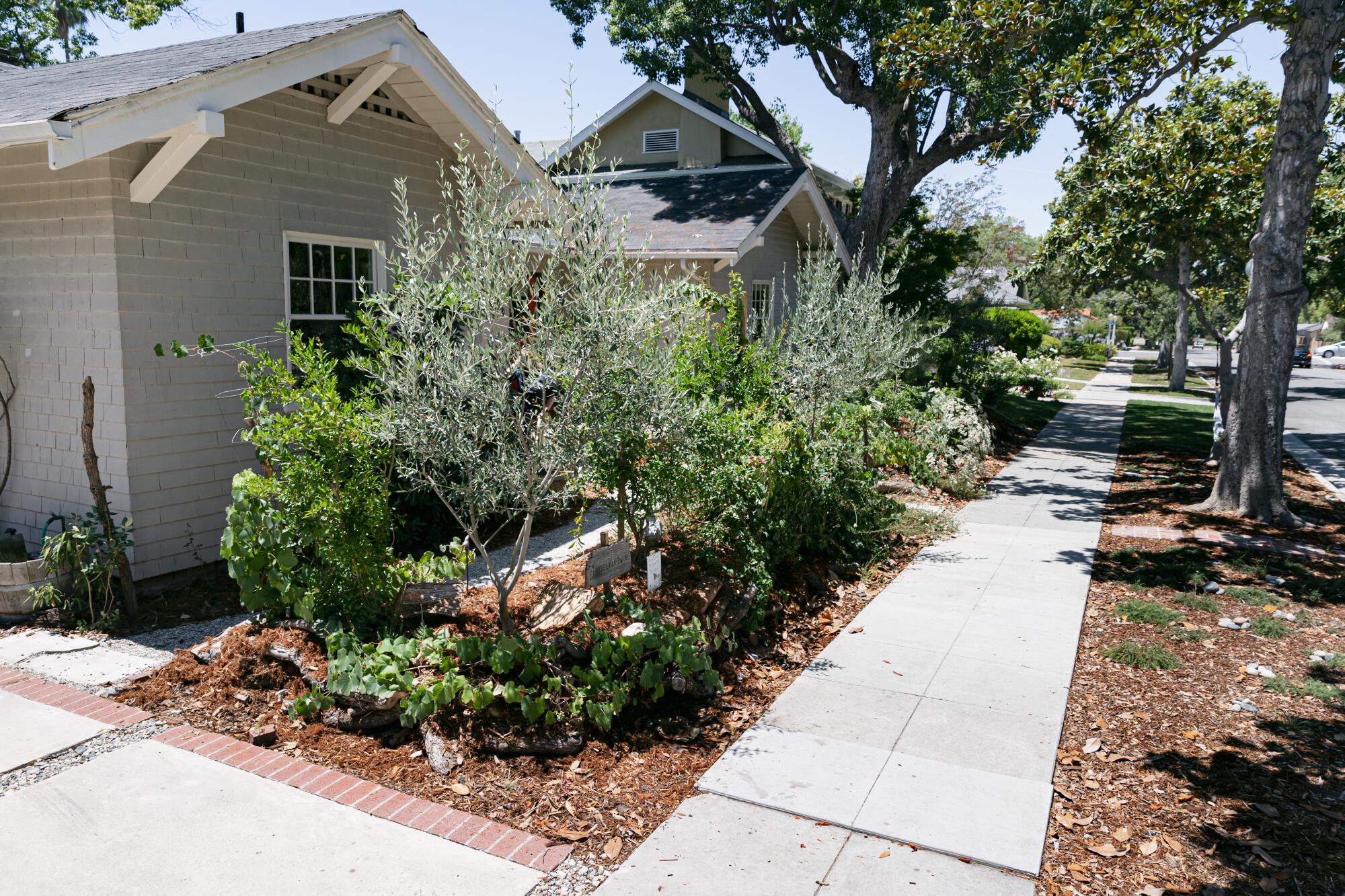
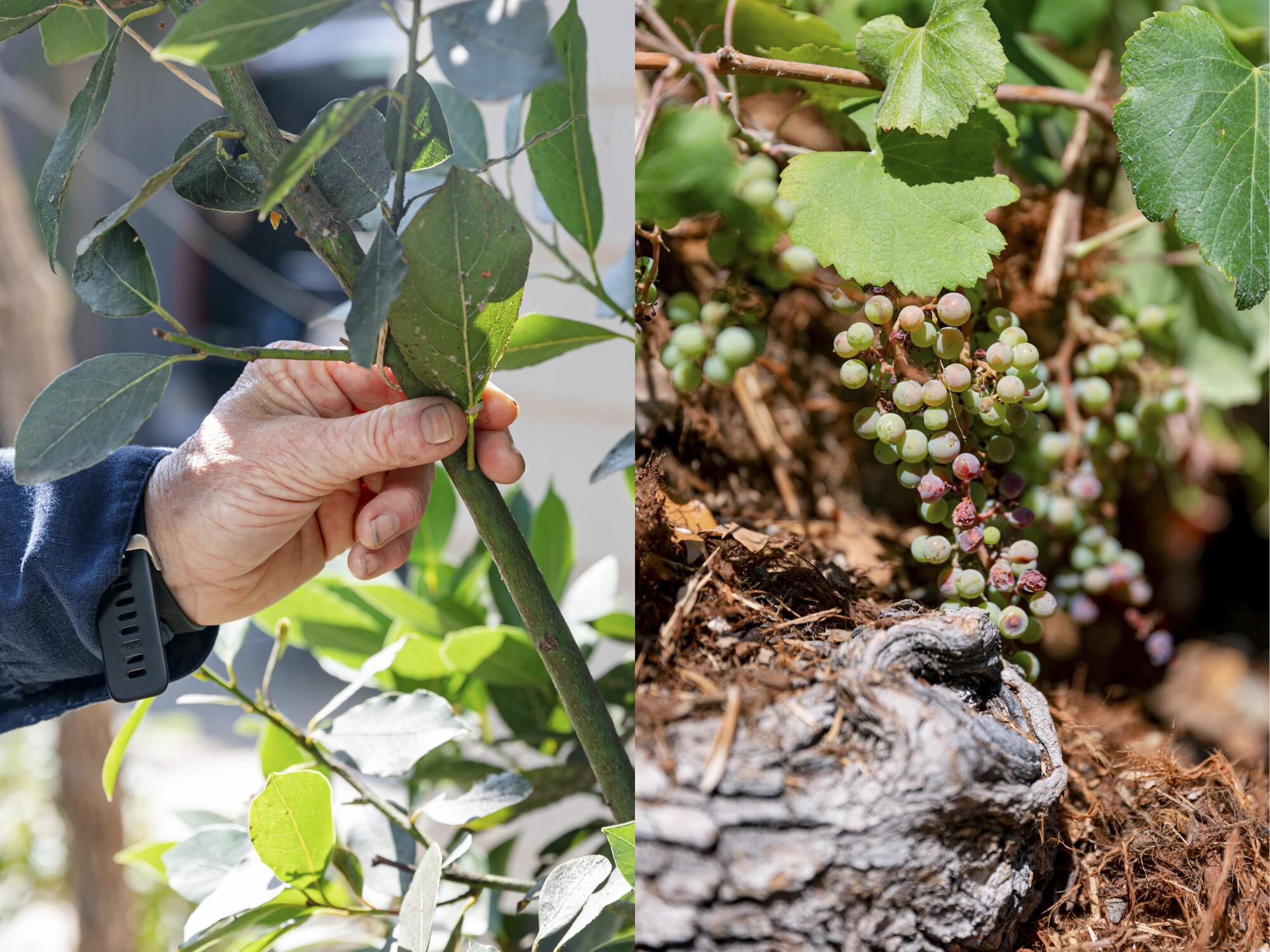
She’s now at the stage where she can play a little in her garden, adding a nest full of seeds to attract birds and a hammock on her parkway, which gives the yard a more rural and rustic feel. Excited about saving more water, she hired someone to pull out the bricks that had been cemented in between the large concrete pavers in her driveway. The bricks looked nice, she said, but now the cracks are filled with gravel so rainwater can sink into the ground and not run down the drive.
“That driveway has always been a heat island,” she said. “Someone probably paid a lot to put in those bricks and make it look pretty, but now when I’m watering plants along my driveway the water isn’t running into the street. It stays in [my] yard and it’s cooling my driveway, which is such a thrill to me.”
Finding your favorite nursery can be thrilling. Here are our picks for the best independently owned plant nurseries near Los Angeles.
Bottom line for O’Brien? Converting her lawn and building hugels gave her creative purpose during the pandemic, and the things she’s learned in the workshops and work parties have empowered her to do more than just wring her hands over the drought.
“You can say I definitely drank the Kool-Aid, but it’s important to do these things because they help cool the Earth and enrich the soil,” she said. “I can’t begin to know everything about everything, but this? This is something I can do.”
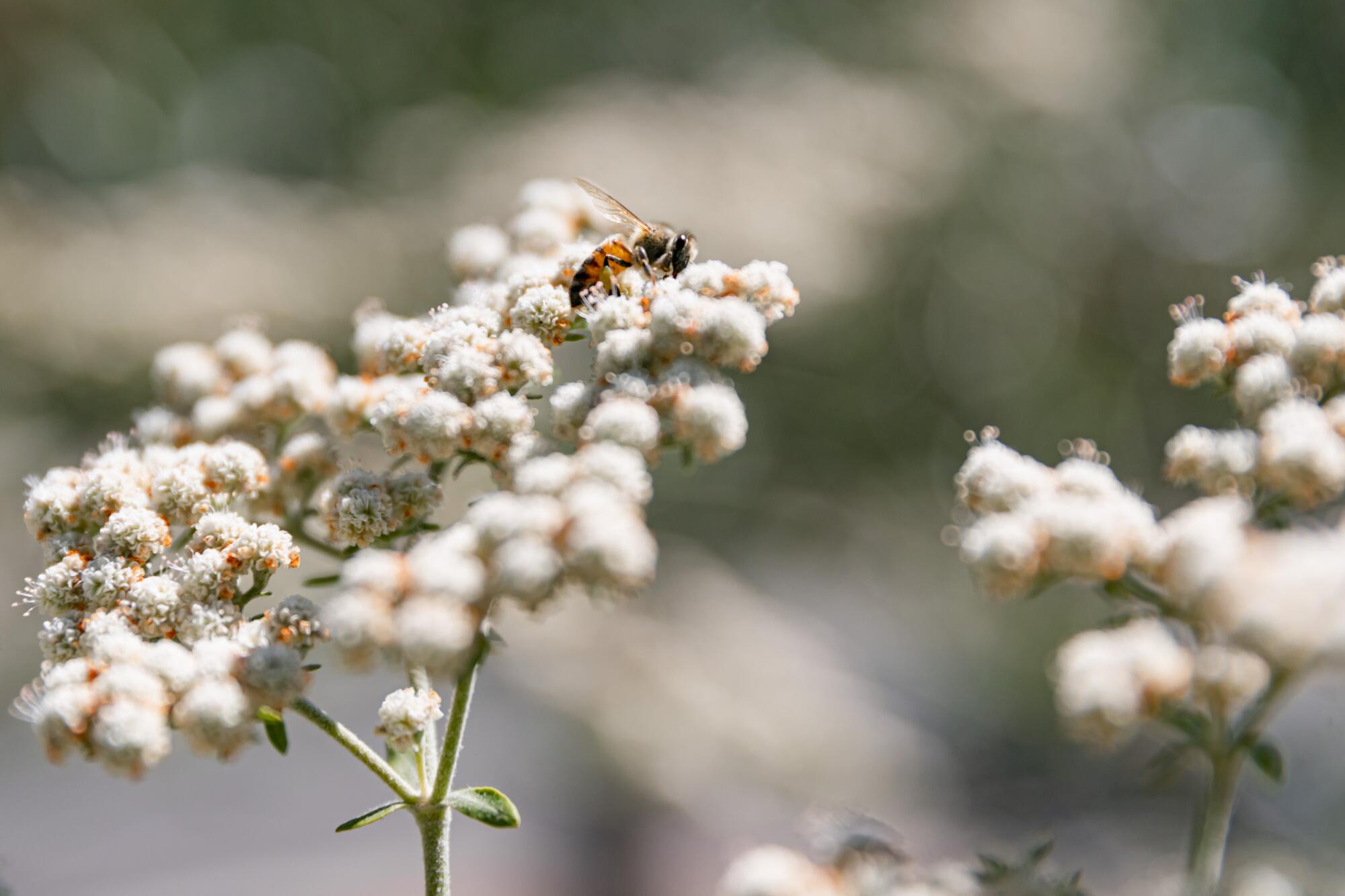
Plants used in this garden
California native shrubs/flowers/fruits
- St. Catherine’s lace (Eriogonum giganteum)
- California buckwheat (Eriogonum fasciculatum var. fasciculatum)
- De La Mina verbena (Verbena lilacina ‘De La Mina’)
- Coyote mint (Monardella sheltonii)
- California goldenrod (Solidago velutina ssp. californica)
- Toyon (Heteromeles arbutifolia)
- Coffeeberry (Frangula californica)
- Common yarrow (Achillea millefolium)
- Roger’s Red grape (Vitis ‘Roger’s Red’)
- Ray Hartman ceanothus (Ceanothus ‘Ray Hartman’)
- Snow flurry mountain lilac (Ceanothus thyrsiflorus ‘Snow Flurry’)
Drought-tolerant, Mediterranean climate plants
- Crape myrtle
- Olive trees (fruited)
- Bougainvillea
- Bay laurel
- Oregano
Other plants
- Pumpkin (a volunteer, likely from compost)
- Daikon radish (good for breaking up compacted soil)
- Sungold tomato
- Pomegranate
- Camellias (part of original landscape)
- Azaleas (part of the original landscape)
Helpful resources for waterwise gardening
- The Waterwise Garden: Designed by Nature by the Metropolitan Water District of Southern California
- Inland Valley Garden Planner
- California Native Plant Society
- Bewaterwise.com
- Socalwatersmart.com
- California Friendly Maintenance Guide
- Virtual classes on tearing out your lawn, irrigation, soil, garden design from Green Gardens Group
- Theodore Payne Foundation for Wild Flowers & Native Plants
- California Native Plant Society’s Calscape
- Homegrown National Park
- UC Master Gardener Program
More to Read
Sign up for This Evening's Big Stories
Catch up on the day with the 7 biggest L.A. Times stories in your inbox every weekday evening.
You may occasionally receive promotional content from the Los Angeles Times.

